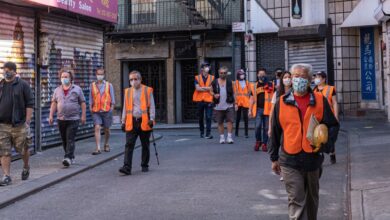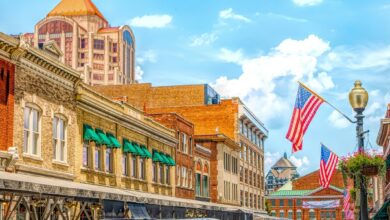The Emigrant Becomes a Giant Projector Screen


Kitsch Klimt on Chambers Street.
Photo: Mark Zhelezoglo for the Hall of Lights
Is there a more permanently obsolete workspace than a grand banking hall with fancy railings above the tellers and a round stone table for writing checks and filling out withdrawal slips? Stepping into the old Emigrant Savings Bank on Chambers Street feels like stepping into the past, and not just because some of us barely remember cash, let alone savings books and the carbon paper. This public room dates from a time when daily routines were ennobled by design. Buying a stamp, consulting a library book, buying a train ticket, depositing a paycheck, paying a tax — each of the paperwork routines that kept society running — got a Beaux-Arts temple adorned with marble, as if greatness was the birthright of every New Yorker. Banks had specific architectural needs: all that marble and stone proclaimed a reassuring permanence, the certainty that your money was handled by sober people working within thick walls – and indeed, the walls survived the money.
Today we can perform most of these rituals without getting out of bed, and many spaces built for them have either found new uses or been abandoned. (You can, however, still read a book amid the Beaux-Arts opulence of the New York Public Library’s Rose Reading Room.) That the Emigrant Savings Bank still exists is a miracle of the moment. In the 1960s, the city planned to demolish it, along with several other nearby buildings, to make way for a new civic center. The project dragged on until the tax crisis of the 1970s made it thankfully unaffordable, and for years it was familiar to car owners as a place to pay parking tickets. Eventually, the Monuments Preservation Commission designated the hall as one of the few protected interiors in the city, which meant that it could not be destroyed (or significantly altered), but also that it could not not be used easily.
Lately, these ornate white marble elephants have turned into venues for fundraising and corporate parties. Once emblems of egalitarian democracy, they have become off-limits to anyone not on the guest list. Restaurant-club-events company Cipriani has taken over the Merchants’ Exchange, the Battery Maritime Building, the Cunard Building (including its lavish ticketing lobby), and the Bowery Savings Bank. On the other hand, the restored and reborn Emigrant Room is accessible to anyone with $30 and a taste for digital glitz. (The rest of the building has been converted into condos.) French company Culturespaces has turned it into the Hall of Lights, a home for the kind of wraparound digital art exhibit that might seem better suited to a featureless hangar rather than ‘to a capricious and tricky landmark. . The first in the Hall of Lights’ repertoire is “Gustav Klimt: Gold in Motion,” a 35-minute, multi-screen tribute to the master of all that glitters, created by Gianfranco Iannuzzi. (This is followed by a shorter tour through the work of artist and architect Friedensreich Hundertwasser, who designed one of the most deliciously weird apartment buildings.) Architectural firm Woods Bagot and preservation consultants Higgins Quasebarth & Partners oversaw a surgical restoration that maintained the bank from the inside while adapting it as a sort of black box. Several counters had to disappear, but the bulk remains, and the central table has been reinstalled. The Landmarks Preservation Commission objected to darkening windows facing Chambers Street, so that a set of curtains isolates a bright vestibule from the darkened heart of the space. Fine Arts Elliptical headlights on the ceiling have regained their vintage luster, now that decades-old cigarette smoke has been eliminated.
The Beaux-Arts interior depicts Vienna.
Architectural details are mostly intact, by order of the Landmarks Preservation Commission.
The windows were closed with curtains rather than blacked out.
Photographs: Mark Zhelezoglo for the Hall of Lights
That’s a lot of effort and expense to put into a design that the audience will only catch a glimpse of while waiting for the show to begin. Yet, deep in the DNA of the immersive art exhibition is the sound and light, a sound and light show invented for a Loire chateau in 1952 and popularized over the following decades, in which historical events were projected onto the facade of a monument or cathedral to a thundering soundtrack of scenic dialogue , music and cannon shots. Today, these quaint entertainments have gone extreme, with bustling facades that make gothic architecture seem to dance and swell and digital trickery so overdone that ancient stone structures sit awkwardly while their insubstantial avatars play.
When the lights go out for Culturespaces’ latest extravaganza, the room’s structure remains visible, but its details are effectively painted over. New York becomes an ersatz of Vienna, and a beautiful space is transformed into another: the Kunsthistorisches Museum. First, a light pencil redraws the walls, columns and arches. Then the camera zooms in so close to the work that it practically flies across the surface.
The allure of the close-up is obvious. Ten years ago (and still in 2018), the real Kunsthistorisches Museum build a temporary bridge above the main staircase so viewers can approach the murals that Klimt painted there. It all seems so pointless… heavy, so boringly local. Why bother with all that scaffolding when you can turn paint into light, enlarge images even further, and wave them in front of a viewer thousands of miles away? There is perhaps no need to discuss the value of seeing real objects in the flesh. A century and more of recording, photography, video and 3D modeling hasn’t killed live performance or shut down art galleries.
And yet, all these dazzling simulacra create a desire for the real; anyone can spend the whole day contemplating the mona-lisa in ultra high resolution online, but crowds still form to squint at the actual painting as it hides behind glass and a phalanx of selfie sticks. Paintings may seem two-dimensional, but they exist in a three-dimensional world. They have a weight, thickness, and physical presence that keep museums and auction houses going. Culturespace depends on audiences eager to see art reproductions in non-replicable environments, but the fact is that Klimt’s virtuosity is not heightened by being digitally splashed on every available surface. The hyperventilating, hyperreal yet psychedelic style of “Gold in Motion” eliminates the distinction between artwork and merchandising. It’s less an animated Klimt than an animated Klimt tie, the gift shop comes to life.
The video takes viewers through several stages of the artist’s career, but the carousel of images scrolls by so quickly that it’s impossible to study one or organize them into a story. What remains is a series of glimpses, a museum retrospective cut up and reassembled into enlarged, nervous fragments. The supposedly immersive experience peddles the ultimate superficial impression. Without narration, without context, without pauses to explain, we get a parade of floating images accompanied by music that varies from the apt (Mahler) to the anachronistic (Philip Glass). And because it’s family entertainment, Klimt’s libido-infused art gets an airplane movie edit, with sensibly cropped nudes, light on masturbation.
The section on the Viennese Secession winks at the central aspiration of the movement: an entire world conceived according to a set of new aesthetic principles at the turn of the 20th century. Architecture sticks to architecture, as Vienna’s bright botanical facades briefly occupy the bank’s curvaceous interiors. There is an affinity here: the bank’s architect, Raymond Almirall, was a contemporary of Klimt and Josef Maria Olbrich (who designed the Secession Building in Vienna), although his heart and training are in Paris. The soft curves, elliptical shapes and clean classicism of the bank hall give it muted echoes of Viennese modernism. But why even establish these links if you want to reduce them to insignificance?
In only one case does Klimt’s work really lend itself to this digital dissolution. when he painted Beethoven frieze for the 14th exhibition of the Secession in 1902, it was intended to be almost as ephemeral as a symphonic performance. Once the show was over, the frieze would be removed. (Like the Emigrant Savings Bank, it survived by chance and now occupies its own gallery in the basement of the Secession Building.) The layering of artistic and musical genres and personalities who contributed to the event is dizzying. Klimt’s painting vibrates to the rhythm of Schiller’s poetry, the Wagnerian account of Beethoven’s music and Max Klinger’s sculpture depicting the composer as hunched and shirtless hero, as well as Olbrich’s architecture. Iannuzzi steps in to add a digital layer to this palimpsest, rubbing the frieze with his camera as “Ode to Joy” blares over the speakers. But in every other sense, he ignores complexity, history and meaning, preferring traffic in gilding.
Perhaps the immersion craze is a reaction to the hypnotic pull of the tiny screens we all carry around in our pockets. It is an invitation to look up and around rather than down, to inhabit an imaginary world instead of scrutinizing it in miniature. If so, its competition is not museums or the artworks they keep locked away in their modest settings, but the ubiquity of digital glare. Of the multitudes who will line up for virtual Klimt, few may have seen his paintings in the flesh; many others were raised on CGI movies and sports-themed video games so vivid you can practically smell the sweat. Art and architecture are irrelevant; the main things are gold and movement.




